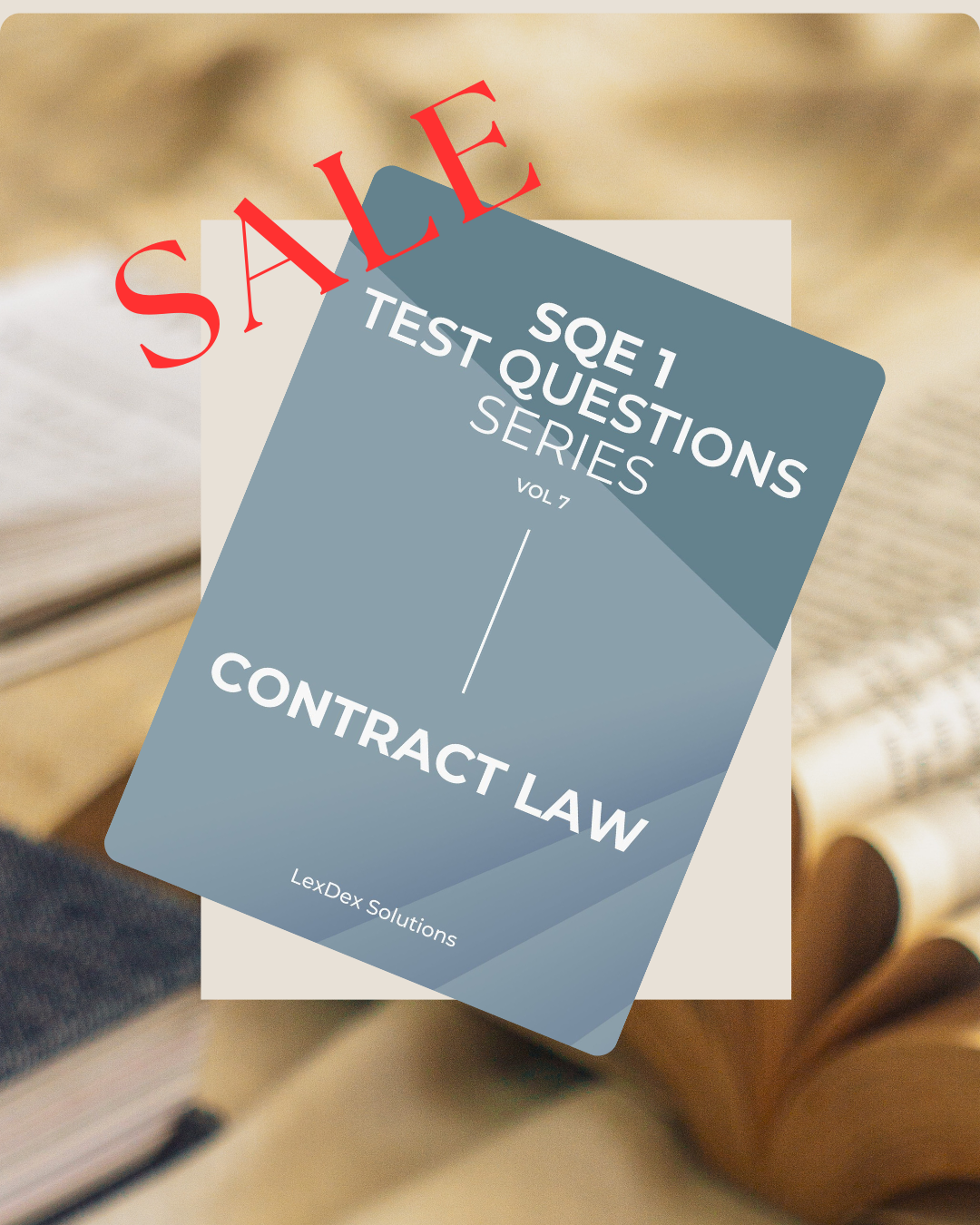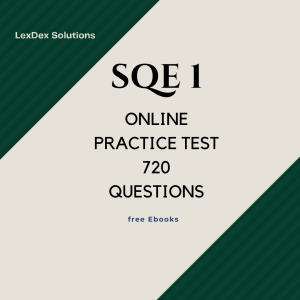Contract Law for SQE1 is one of the cornerstones of the Solicitors Qualifying Exam, and mastering it efficiently is critical for success. Unlike purely academic exams, SQE1 tests not only what you know but also how you apply law to complex, multi-layered scenarios, often under strict time constraints. Memorising Contract Law quickly requires strategic methods that integrate understanding, recall, and application, so you can confidently tackle any question, from formation of contracts to remedies for breach. In this post, we’ll explore lawyer-tested techniques to help you internalise principles, landmark cases, and problem-solving strategies for the exam.
1. Focus on High-Yield Topics First
Contract Law for SQE1 is a broad subject, but not every topic carries the same weight in the SQE1 exam. High-yield topics of Contract Law for SQE1,csuch as formation of contracts, terms, vitiating factors, breach, and remedies consistently appear in past papers and are essential for scoring well. Prioritising these areas allows you to consolidate core knowledge first, giving you a foundation to build upon when studying secondary topics like exclusion clauses or third-party rights. By targeting the most frequently tested principles, you reduce wasted time on low-yield material and maximise your revision efficiency.
Formation of Contracts: The basic structure of a contract involves offer, acceptance, consideration, and intention to create legal relations. Many students struggle because they fail to differentiate between mere invitations to treat and enforceable offers, which can dramatically change the outcome in scenario questions. Understanding this distinction, and applying it to problem questions, ensures you avoid fundamental errors that could cost significant marks.
Terms of Contracts: Terms are central to assessing rights and obligations. It is vital to distinguish between express, implied, and innominate terms, as each type has different consequences for breach and remedies. By systematically reviewing these distinctions and linking them to cases such as Bettini v Gye or Hong Kong Fir Shipping, you will be able to identify the correct legal framework in scenarios efficiently.
Vitiating Factors: Misrepresentation, mistake, duress, and undue influence can invalidate contracts or provide grounds for remedies. Students often memorise definitions but fail to apply the facts accurately to determine whether a contract is void or voidable. Practising application of these factors through scenario-based questions helps embed the principles and prepares you for the unpredictable twists in the exam.
Remedies: Understanding remedies goes beyond knowing the types — damages, specific performance, and rescission. You must be able to calculate damages where appropriate, discuss discretionary equitable remedies, and justify the application of each remedy. This ensures your answers are not only technically correct but also persuasive and aligned with practical legal reasoning.
2. Use Concise Case Summaries
Trying to memorise full case reports is inefficient and overwhelming. Instead, create concise summaries that capture the essence of each case, including key facts, legal principles, and outcomes. This approach allows rapid recall under exam conditions without compromising understanding.
Facts in One Sentence: Condense the case facts into a single, clear sentence. For example, Carlill v Carbolic Smoke Ball can be summarised as: “Defendant advertised a reward for using the smoke ball, which led to performance by claimant, raising enforceability issues.” This practice forces you to focus on what is legally relevant, avoiding distraction by peripheral details.
Legal Principle: Extract the ratio decidendi, the binding legal principle, for each case. For instance, in Balfour v Balfour, the principle is that agreements between spouses may lack intention to create legal relations unless clear evidence indicates otherwise. Summarising in this way ensures you can immediately recall the legal rule and link it to scenario questions.
Outcome: Note the outcome concisely to understand how courts apply principles to facts. This is crucial for your ability to predict results in exam scenarios and provide reasoned, structured answers. By practising with summaries, you train your mind to identify relevant legal principles quickly and avoid overloading with unnecessary detail.
3. Apply Active Recall and Spaced Repetition
Memorisation without active retrieval is ineffective, especially for complex subjects like Contract Law. Active recall involves testing your memory repeatedly without referring to notes, which strengthens retention and ensures concepts move into long-term memory.
Flashcards: Create flashcards for each doctrine, case, or rule. On one side, write the scenario or principle, and on the other, the key rule or case. By testing yourself repeatedly, you force your brain to retrieve information, strengthening your ability to apply it in high-pressure exam situations.
Problem Questions: Practice applying principles to mini-scenarios daily. Do not simply read model answers; instead, attempt a question, formulate an answer, then compare to the correct solution. This not only reinforces memorisation but also enhances application skills, which is the primary focus of SQE1.
Spaced Repetition: Return to topics at increasing intervals. For example, review formation of contracts today, again in three days, then a week later. This method exploits the brain’s natural memory consolidation process and prevents rapid forgetting, a common pitfall in intense exam preparation.
4. Link Principles to Practical Scenarios
Understanding abstract principles is only part of the battle — you must also anchor them in practical scenarios. This allows you to recall principles effortlessly when faced with problem questions.
Scenario Creation: For each legal principle, devise two or three mini-scenarios that illustrate correct and incorrect application. For example, for misrepresentation, create one scenario with a fraudulent statement and another with a negligent misstatement. Practising with these helps you internalise the application of law, rather than just memorising definitions.
Discussion: Explain scenarios aloud or with a study partner. Talking through the principles forces you to structure reasoning clearly, anticipate counterarguments, and internalise the correct approach. The SQE rewards precise reasoning, so verbalising your thought process is a highly effective technique.
Pattern Recognition: Over time, you will notice recurring fact patterns, such as issues with consideration or breach types. Recognising these allows you to apply the correct principle automatically, speeding up both memorisation and exam performance.
5. Use Visual Aids and Mental Maps
Complex interconnections in Contract Law for SQE1, such as formation, terms, breach, and remedies, can be overwhelming. Visual aids like flowcharts and mind maps help structure your knowledge hierarchically.
Flowcharts: Map each stage of contract formation and link it to potential issues, vitiating factors, and remedies. This visual representation allows you to see the logical flow and reduces cognitive load during revision.
Mind Maps: Connect doctrines, cases, and exceptions using colour-coded diagrams. Highlight exceptions in red and common principles in green. This method not only aids memorisation but also creates a visual memory, making it easier to recall under timed conditions.
Integrated Notes: Combine visual aids with brief written notes summarising principles, so you can revise quickly without reading full textbooks. This dual coding — visual plus textual — has been proven to enhance retention significantly.
6. Practice Under Timed Conditions
Ultimately, memorisation is meaningless unless you can apply the knowledge under exam conditions. SQE1 is timed, scenario-driven, and tests reasoning as much as recall.
Timed Problem Questions: Set a timer and answer a question from each topic area. This simulates exam conditions and trains your mind to prioritise relevant facts and apply law quickly.
Reflection: After completing each question, review your answer, identify mistakes, and note where reasoning could be improved. Repeating this process not only consolidates memorisation but also develops your legal thinking skills, which are crucial for SQE1 success.
Iteration: Rotate through all topics systematically. The combination of memorisation, application, and timed practice ensures that knowledge is deeply embedded and readily retrievable during the exam.
FAQs for Contract Law for SQE1
Q1: How quickly can I memorise Contract Law for SQE1?
A: With focused, strategic revision using high-yield topics, case summaries, and active recall, it is possible to internalise core principles within a few months. Consistency and application are key.
Q2: How many cases do I really need to know?
A: Memorise landmark cases and key illustrative examples. Depth of understanding and the ability to apply principles is more important than rote memorisation of dozens of minor cases.
Q3: Should I use handwritten notes or digital tools?
A: Both work, but handwritten notes aid retention through muscle memory, while digital flashcards allow spaced repetition and portability. Combining both is highly effective.
Q4: How do I integrate memorisation with practice?
A: Immediately apply memorised principles to mini-scenarios or past paper questions. This reinforces learning, identifies gaps, and trains your mind for real exam conditions.
Don’t forget About Your Career While Preparing for SQE1
While preparing for SQE1, don’t overlook your CV and professional presentation. At Lawlio, we specialise in UK student CVs tailored for law students and aspiring solicitors, ensuring your skills, experience, and potential are communicated effectively. Pair strong exam preparation with a standout CV to maximise your career opportunities.

